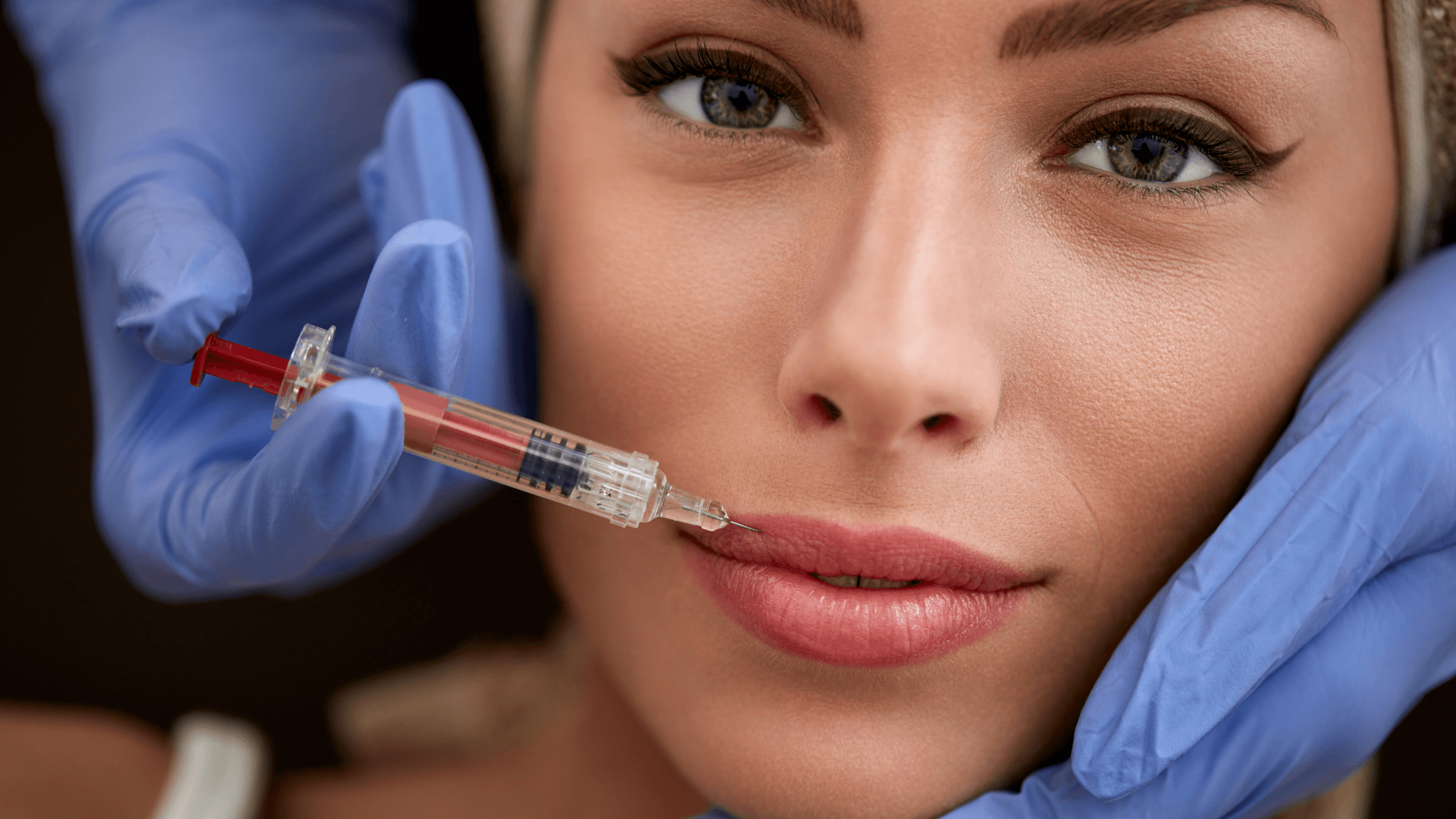
Let’s face it: ever since Kylie Jenner made lip fillers famous, it has been a go-to procedure for anyone who wants plumper, more defined lips!
Lip fillers, like many cosmetic procedures, offer a variety of benefits. While there can be concerns, one such as lip filler migration is manageable and not uncommon.
To shed light on lip filler migration, Aesthetica is here to guide you through it and shed some light on this common mishap.
Understanding Lip Filler Migration
At its core, lip filler migration refers to the displacement of hyaluronic acid-based fillers.
These fillers, designed to enhance lip volume and shape, sometimes move away from the targeted area, making your lips look a little “spread out.”
Causes of Lip Filler Migration
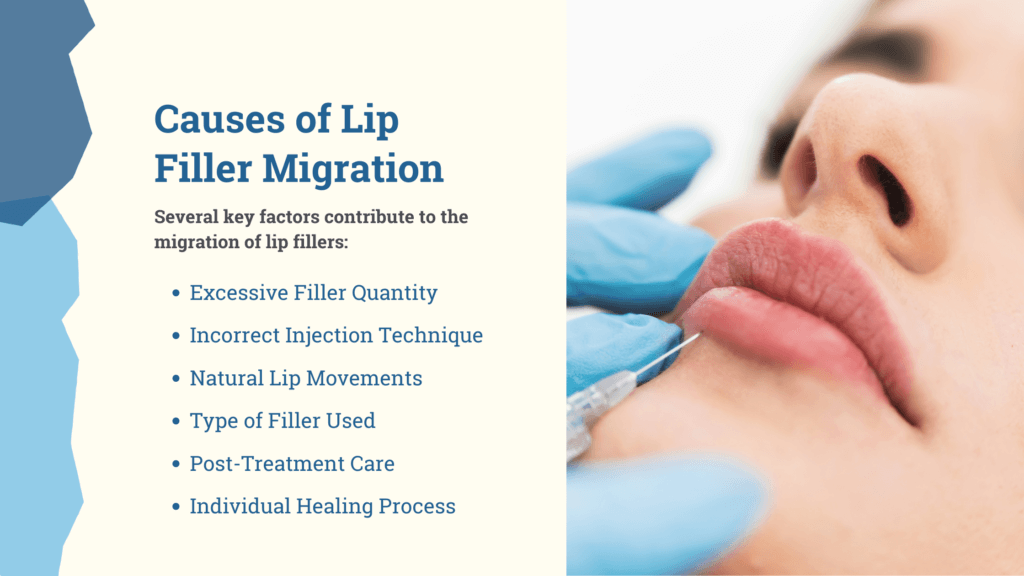
Several key factors contribute to the migration of lip fillers:
- Excessive Filler Quantity: Injecting too much filler material has been known to lead to migration. The lips can only hold a certain amount of filler comfortably. The excess material naturally seeks space when overfilled, moving beyond the lip border.
- Incorrect Injection Technique: The technique and precision of the injector are critical. Wrong methods, such as injecting filler too superficially or too deeply or not placing the filler evenly, can lead to migration. The skill and experience of the practitioner play a significant role in preventing this issue.
- Natural Lip Movements: The dynamic nature of the lip area also influences filler migration. Regular movements such as talking, eating, and facial expressions can cause the filler to shift, especially if it hasn’t fully integrated into the lip tissue after the procedure.
- Type of Filler Used: Some fillers have different consistencies or densities. Some are more prone to migration than others, especially those that are thinner or have a lower viscosity.
- Post-Treatment Care: How you care for your lips after the procedure also impacts the likelihood of migration. For instance, applying pressure or massaging the lips too soon after treatment can encourage the filler to move.
- Individual Healing Process: Each person’s body reacts differently to fillers. Factors like metabolism, tissue structure, and healing capacity can influence how well the fill stays in place.
Signs of Lip Filler Migration
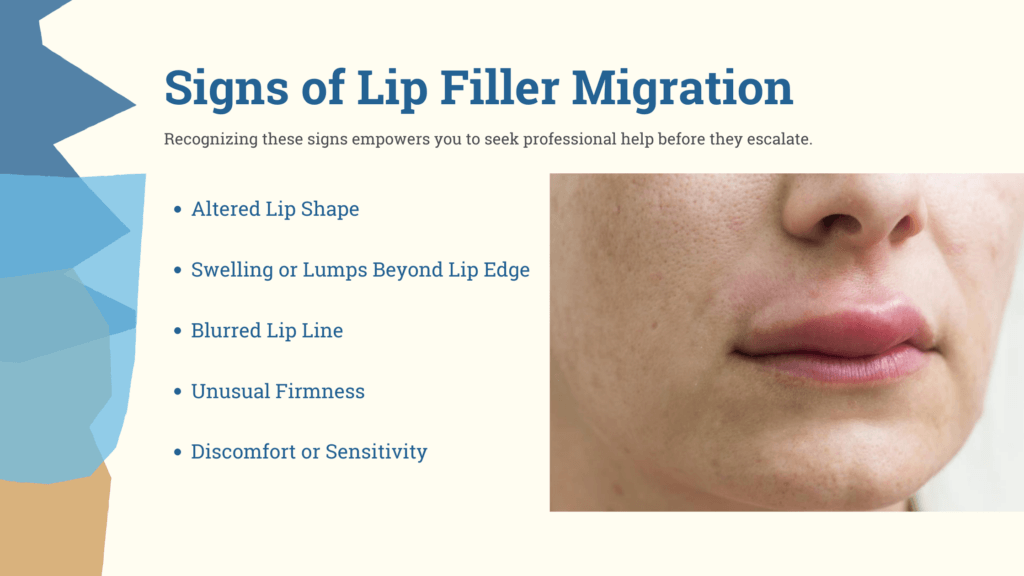
Identifying the early signs of this migration is essential for timely corrective action. Below, we delve into the key indicators that suggest your lip filler might have migrated.
Recognizing these signs empowers you to seek professional help before they escalate.
- Altered Lip Shape: One of the most noticeable signs is a change in your lip shape. If the filler has migrated, your lips may appear uneven or distorted, losing their natural contours.
- Swelling or Lumps Beyond Lip Edge: Feel for any unusual lumps or swelling beyond the natural lip border. Filler migration often leads to visible bumps or unevenness in the surrounding area.
- Blurred Lip Line: A clear lip line is a hallmark of well-done fillers. If the border of your lips appears blurred or less defined, it might indicate migration.
- Unusual Firmness: If certain areas around your lips feel unusually firm or stiff, it could be due to filler moving away from the intended location.
- Discomfort or Sensitivity: While some discomfort is normal post-injection, persistent or unusual pain around the lips may suggest issues like migration.
What to Do if You Suspect Filler Migration
If you notice any of the above signs, it’s essential to consult with aesthetic practitioners, like Dr. Chang and his expert team. They can assess the situation and suggest appropriate corrective measures.
Treatment options vary depending on the extent of migration. They can range from massaging the area to dissolving the filler with hyaluronidase, an enzyme that breaks down hyaluronic acid.
Preventing Lip Filler Migration
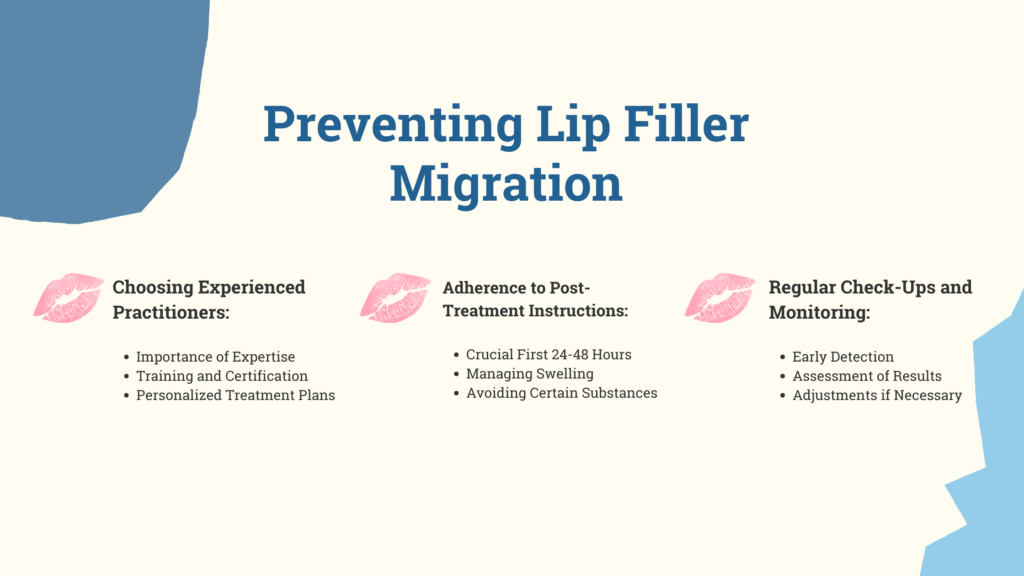
Preventing lip filler migration is as important as addressing it after it occurs. Understanding how to minimize the migration risk can make a significant difference in maintaining the intended results of lip fillers. Following these guidelines can enhance your lip fillers’ longevity and aesthetic appeal.
Choosing Experienced Practitioners
- Importance of Expertise: The skill and experience of the injector are paramount. Experienced practitioners deeply understand facial anatomy and possess the finesse required for precise filler placement.
- Training and Certification: Look for practitioners who have undergone specialized training in dermal fillers and are certified. This background ensures they are up-to-date with the latest techniques and products.
- Personalized Treatment Plans: A skilled injector will assess your specific facial structure and tailor the treatment to your needs rather than using a one-size-fits-all approach.
Adherence to Post-Treatment Instructions
- Crucial First 24-48 Hours: The immediate period after the treatment is critical. During this time, avoid activities that exert pressure on the lips, such as vigorous brushing, kissing, or specific facial treatments.
- Managing Swelling: Follow the practitioner’s advice on managing swelling. This might include using ice packs or specific medications.
- Avoiding Certain Substances: Stay away from alcohol and particular supplements that can increase swelling and affect the healing process.
Regular Check-Ups and Monitoring
- Early Detection: Regular follow-up appointments enable early detection of any signs of filler migration. Addressing these signs promptly can prevent further migration.
- Assessment of Results: During check-ups, practitioners can evaluate the filler’s integration with the lip tissue and the overall aesthetic result.
- Adjustments if Necessary: If there are signs of migration or the results are not as expected, the practitioner can make necessary adjustments. This might include additional treatments or dissolving some of the filler.
By carefully selecting a qualified practitioner, diligently following post-treatment instructions, and regularly consulting with your practitioner for follow-ups, you significantly reduce the risk of lip filler migration.
These proactive measures ensure that your lip enhancement procedure provides a safe and aesthetically pleasing outcome.
While lip fillers can significantly enhance your appearance, being vigilant about potential complications like filler migration is vital. Recognizing the signs early and seeking professional advice ensures your cosmetic enhancements remain safe and aesthetically pleasing.
Aesthetica Clinic's Approach to Cosmetic Enhancements
Aesthetica has carved a niche in offering personalized cosmetic solutions. Our focus on understanding individual aesthetic goals and providing tailored treatments sets us apart.
Our clinic’s expertise in facial filler procedures is complemented by using high-quality products and the latest techniques in the industry.
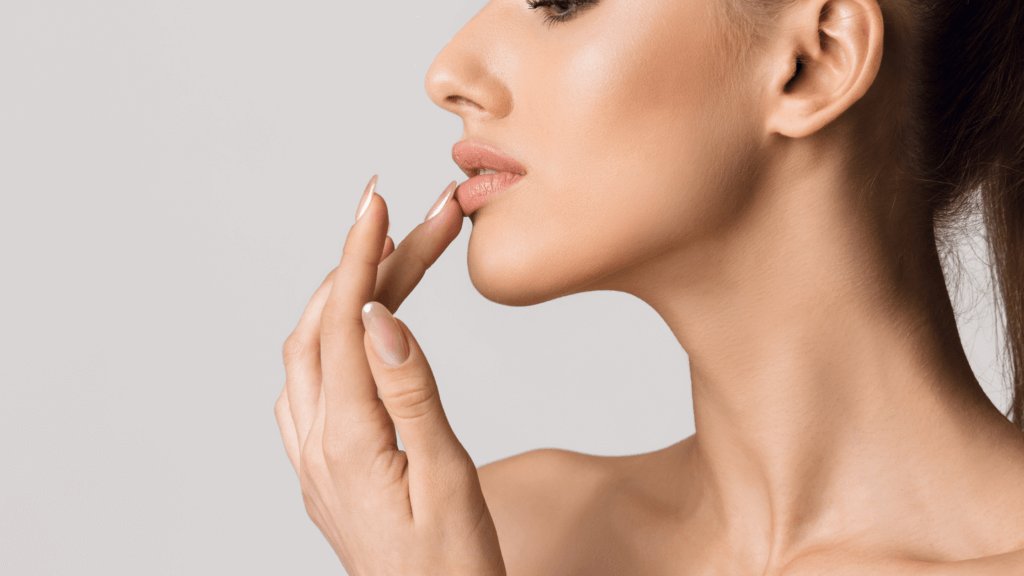
Start Your Lip Filler Journey Today!
Meet us at 19500 Sandridge Way, Suite 350, Leesburg, VA 20176, or call us at (703) 574-4342 for a complimentary consultation with Board-Certified Plastic Surgeon Dr. Phillip Chang before moving forward with your procedure. If everything matches up, our team will help you navigate the entire process from beginning to end. Also, remember to check out our blog and social media for more information on cosmetic surgery trends!
Let Us Help You!
Our office can provide you with helpful information, schedule a free consultation, and walk you through the many services and procedures we provide.
Contact Dr. Chang's Office:
More Articles For You

The Latest Techniques in Double Chin Removal in Leesburg, VA
In the charming town of Leesburg, VA, where looking good and feeling great are top

The Art of Refining the Side Profile of a Woman through Plastic Surgery
In the realm of cosmetic enhancements, the side profile of a woman holds a pivotal

Enhance Now, Pay Later: Plastic Surgery Payment Plans in Leesburg, VA
In the picturesque town of Leesburg, VA, pursuing beauty and self-improvement is a journey many

Areola Reduction for Men in Loudoun County
In the heart of Loudoun County, where the beauty of nature meets bustling urban life,

